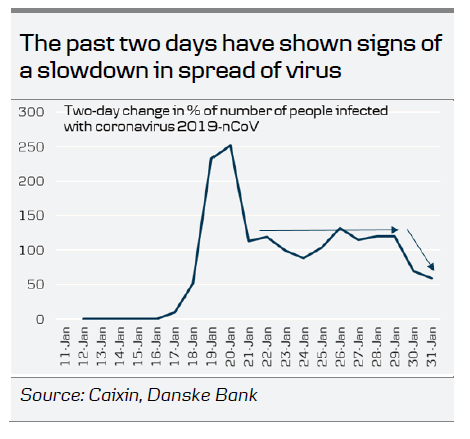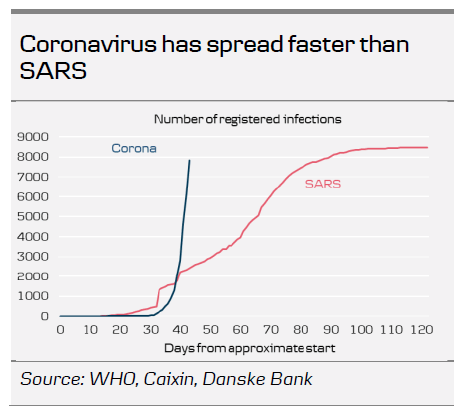- The latest number of infections shows that the growth rate of new infections is slowing down. This is good news as it indicates the measures taken are starting to work and the disease spread will soon decline.
- The spread of the virus outside of China is also still limited and no deaths are registered in other countries yet.
- While uncertainty is still high and we would need to see confirmation of this development, the slower rate of increase will hopefully be verified over the coming weeks. If so, it should bring some relief to financial markets.
The count of infections overnight increased further to 9,821 cases, up from around 8,000 the day before. While the number keeps climbing, the good news is that the growth rate is decreasing. For more than 10 days the virus spread at a rate of more or less doubling in two days (actually a bit more than doubling). If this rate had continued for another week, the numbers would have reached very high levels. However, in the past two days the growth rate has come down, which indicates that each infected person is passing the virus on to fewer people. The growth rate is now down to 60% over two days.
The way a disease normally spreads is like a logarithmic function. In the beginning the disease spreads exponentially as each person infected transmits it to for example two to three people. However, once measures are taken to stop mobility of people, isolate infected and suspected cases and limit big gatherings, the rate of transmission comes down. That means the growth rate levels off and eventually the spread of the disease stops. Based on the current development, the total number of infected people may end around 20,000, although these kinds of forecasts are of course very uncertain.
The bottom chart shows the coronavirus versus SARS in 2003. The starting point for SARS is unclear but it is clear that the coronavirus has spread significantly faster. However, as can be seen from the SARS curve, once the curve flattened out the spread of the virus was reduced significantly. This is why it is important to look out for the ‘kink’ in the corona chart. The timing of the kink is crucial for how high the numbers will be in the end.
A big uncertainty is the reliability of the data as many people could be infected that are not registered due to capacity problems in the Hubei province, where 60% of the cases are registered. The same capacity problems should not be the case outside of Hubei province, though. This may also explain why the mortality rate is close to 0% outside Hubei while 3- 4% inside.
Chinese PMI data for January this morning were broadly as expected and do not show any impact yet. These numbers should be disregarded, though, as they do not capture the period when the coronavirus started to spread fast. We expect a very big drop in both manufacturing and service PMI for February but it should be a temporary drop and we look for a sharp increase in March/April if indeed the coronavirus starts to level off during February and activity levels gradually increase again.














